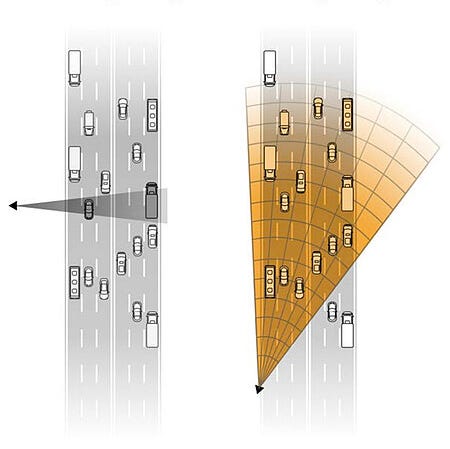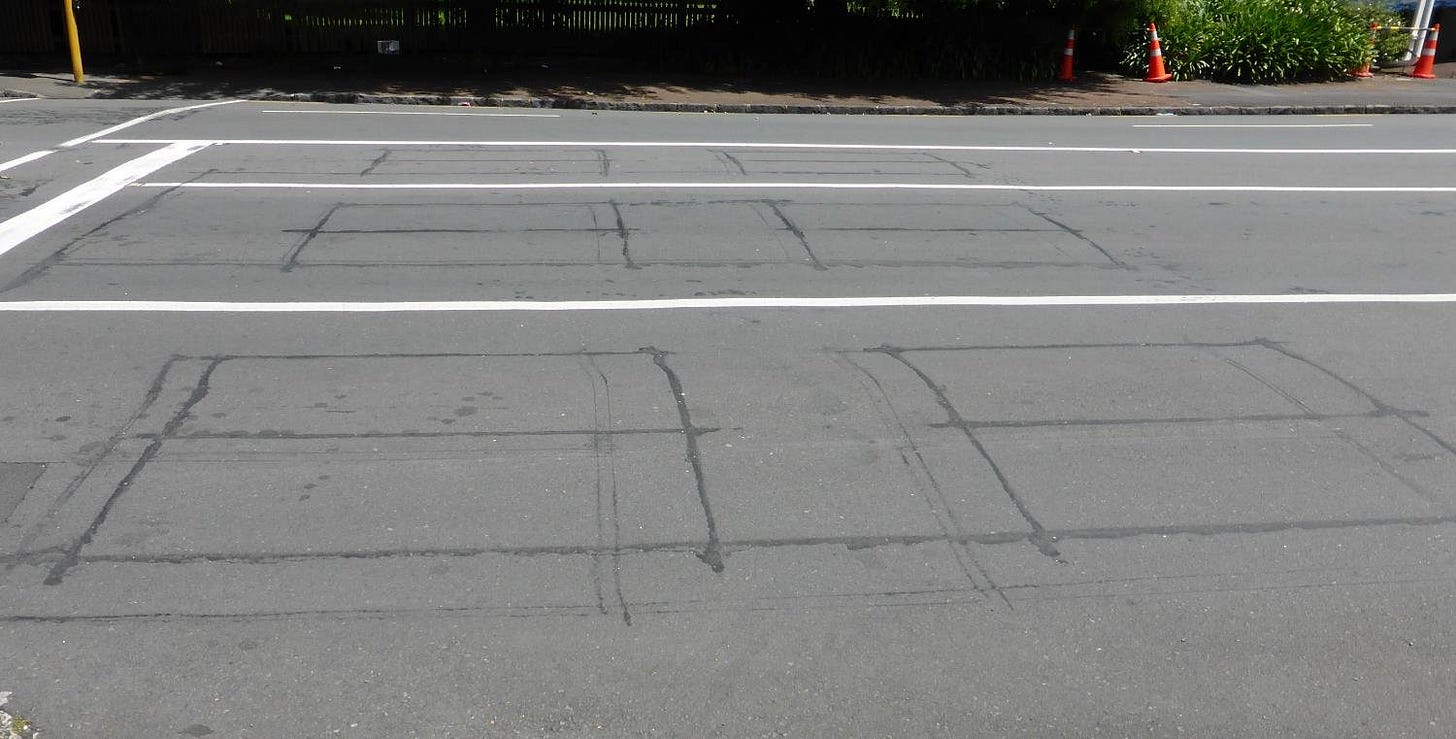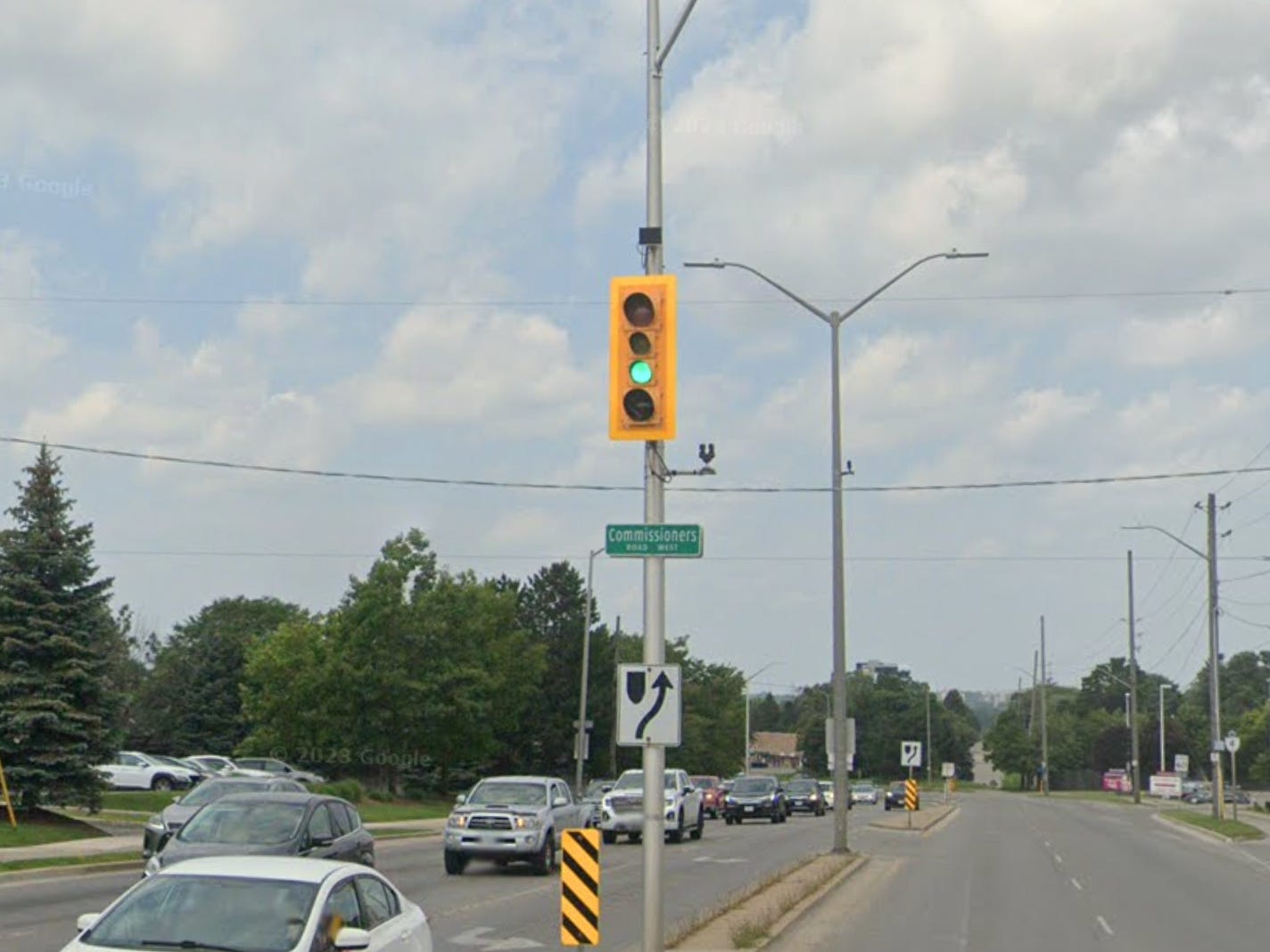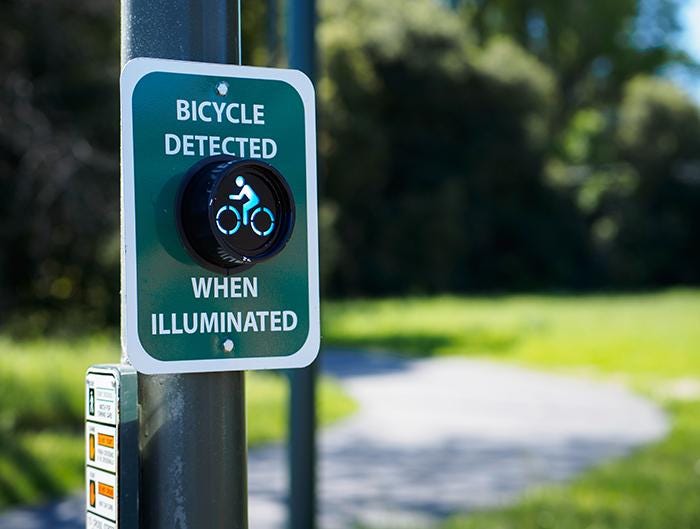One aspect of traffic signal systems that the public takes for granted is vehicle detection. This is one of the most crucial subsystem components of the traffic signal system at an intersection while also representing one of the more significant costs. Therefore, the need for reliable detection is highly important. I wish to discuss how these systems are set up and then delve into a few examples that I'm familiar with. However, I acknowledge that there are likely other detection systems and newer technologies that I may be less familiar with.
Induction Loops
Vehicle detection systems have been around for many decades but have undergone significant evolution this century. Perhaps the most familiar to the majority of people is the induction loop detection system. This system involves an induction coil placed under the pavement, detecting the metal content in a vehicle and triggering the traffic signal system to provide green time when appropriate. This is one of the simplest and cheapest forms of detection and reliable when functioning. However, when failure occurs, the induction loop needs to be re-cut into the pavement. This compromises the pavement near the intersection, causing more wear and tear. In colder climates such as Canada, replacing induction loops is possible only during warmer weather conditions.
Another challenge with loop detection systems arises for vehicles such as motorcycles or bicycles. While these systems can work depending on the metal content of the specific vehicle, in many cases, achieving accurate vehicle detection for motorcycles or bicycles can be a challenge.
Radar Detection
A common type of vehicle detection system in more modern intersections that I've observed is the radar detection system, which generally comes in two primary forms: side-firing or front-firing. While radar technology itself is fairly old and mature, it has made improvements and become more of a staple (at least in my experience) in many locations across Canada.
Depending on the system, radar detection can come with a higher price tag compared to the more basic induction loop detection. The setup and calibration of such systems can be potentially more complex. It's also more challenging to determine the exact size of a detection zone using a radar system compared to an induction system that can be physically defined, as the latter is carved directly into the pavement.
In some radar systems that I have observed, there's a need to create a special setup between the traffic signal controller and the onboard detection unit inside the traffic cabinet that processes the detection for the radar sensors. In some cases, you need to define a specific geometry file using a tool such as Google Maps to map out the intersection in a more physical sense. Even though the images that come from the radar are basic due to the nature of the technology, the challenge lies in the fact that maintenance contractors for municipalities have traditionally been more focused on the electricians' role and less on the technology and networking aspects of these tools. This creates a challenge for those electricians who are less tech-savvy to understand how to set up without additional effort and training.
Video Detection
Another commonly used vehicle detection system in modern intersections is video, which has various design approaches. This can include the visible light spectrum of detection, infrared light, or other portions of the light spectrum. However, it similarly presents challenges in terms of higher costs and calibration when it comes to onboard unit setup within a traffic cabinet and communication with the traffic controller, compared to a more traditional induction loop setup.
Video detection also introduces other challenges that need consideration. One notable concern is the issue of privacy, which becomes more significant for the public when they observe video cameras at an intersection. This is similar to experiences with traffic monitoring cameras. Public concerns over data collection and retention from tools like video cameras persist, with privacy protection being a key aspect. Worries range from zooming into people's faces to identifying personal vehicles using their license plates.
Video cameras may also face environmental challenges depending on the application, including surface snow causing glare on the road, vehicle colours that may render certain vehicles invisible to a camera, and heat profiles for infrared cameras in warmer summer months. While some of these challenges may be over a decade old, newer versions of cameras may have addressed them to some extent. Advances in tools and processing of video images may now include a combination of infrared and visible light cameras, along with improved artificial intelligence for processing to improve detection accuracy as the camera processes and interprets image frames.
Other Detection
A couple of other honorable mentions for detection systems that I have seen, but do not have personal experience in, involve wireless pucks placed under pavement. These are somewhat similar to induction loops but more basic, equipped with an onboard battery that survives for a certain number of years, transmitting wirelessly to a detection system. However, such systems are likely to face operational challenges in colder environments like Canada.
Another honourable mention includes LiDAR systems. LiDAR is a tool that can also be found in other emerging technologies, such as self-driving or automated vehicles, as a means to map out the environment around it. Although it has been used, I have not seen it widely deployed as a vehicle detection system in my area of Canada.
Detection Considerations
It's also worth noting that more modes of travel require detection these days including bicycle detection, which has traditionally been a challenge. There has been improved success through modern detection systems such as radar, as well as providing optional feedback to cyclists through a lit-up indicator.
Transit and integrations with transit signal priority or emergency vehicle preemption also play a role in vehicle detection. However, these topics can get more complex, and for this article, I will avoid delving into them here.
Lessons Learned
Overall, I am generally agnostic when it comes to a preferred detection system. I believe it depends on the use case and the environment in which it is being deployed. Based on my experience, I see a lot of benefits in various mainstream technologies, including induction loops, radar, and video. Each technology has its pros and cons, as is the case with any technological solution. I also acknowledge challenges in how these technologies are implemented. However, it is also challenging from an operational and maintenance perspective to use a wide variety of detection systems within a single jurisdiction, so it is advisable to limit the choice to 2-3 systems to cover most use cases.
Given my experience and how these technologies have evolved over recent decades, I do not doubt that breakthroughs and advancements, including enhancements through emerging tools such as artificial intelligence, will allow these technologies to thrive and improve in the years to come.
From my experience, I believe that most traffic signal practitioners have a general wish list for these detection technologies including that they have a more modest capital cost, minimal setup time and maintenance, and enhanced accuracy and reliability, especially in poor weather conditions. Perhaps this is too generic of a wish list, but we can keep striving towards the “holy grail” of vehicle detection in our technological pursuits!
What are your personal experiences in your profession with vehicle detection systems? Which ones do you prefer and which ones do you dislike using?









